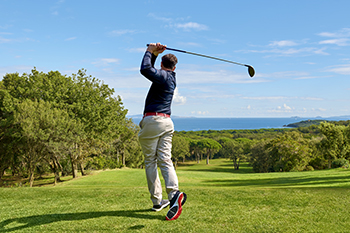
Foot pain can interfere with your enjoyment of golf, particularly pain in your big toe, heel, and ball of the foot. Foot pain can result from stiff joints, stretched-out tissues, and nerve damage. Relief is possible and often without surgery. The three most common foot conditions sustained by golfers are neuromas, arthritis, and heel pain. A Morton’s neuroma is a thickened, enlarged nerve in the ball of the foot that is compressed or irritated. This can cause pain when transferring weight from one foot to the other while swinging a golf club. Arthritis in the joint of the big toe also makes it difficult to follow through on a swing. Heel pain from plantar fasciitis, an inflammation of the band of tissue that runs from the heel to the ball of the foot, makes it uncomfortable for a golfer to maintain a solid stance while swinging the golf club. Less common afflictions that can cause pain and interfere with golf include ankle arthritis, Achilles tendonitis, and corns and calluses. If you golf and are suffering from foot pain, consult with a podiatrist who will be able to diagnose the problem and provide appropriate treatment so that you are back to good golf form as quickly as possible.
Ankle and foot injuries are common among athletes and in many sports. They can be caused by several problems and may be potentially serious. If you are feeling pain or think you were injured in a sporting event or when exercising, consult with Emmanuel Bustos, DPM from New York. Our doctor will assess your condition and provide you with quality foot and ankle treatment.
Common Injuries
The most common injuries that occur in sporting activities include:
- Achilles Tendonitis
- Achilles Tendon Rupture
- Ankle Sprains
- Broken Foot
- Plantar Fasciitis
- Stress Fractures
- Turf Toe
Symptoms
Symptoms vary depending upon the injury and in some cases, there may be no symptoms at all. However, in most cases, some form of symptom is experienced. Pain, aching, burning, bruising, tenderness, tightness or stiffness, sensation loss, difficulty moving, and swelling are the most common symptoms.
Treatment
Just as symptoms vary depending upon the injury, so do treatment options. A common treatment method is known as the RICE method. This method involves rest, applying ice, compression and elevating the afflicted foot or ankle. If the injury appears to be more serious, surgery might be required, such as arthroscopic or reconstructive surgery. Lastly, rehabilitation or therapy might be needed to gain full functionality in the afflicted area. Any discomfort experienced by an athlete must be evaluated by a licensed, reputable medical professional.
If you have any questions, please feel free to contact our office located in New York, NY . We offer the newest diagnostic and treatment technologies for all your foot care needs.